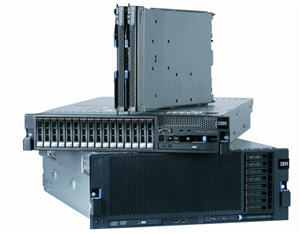IBM hopes to upend industry standard server ROI equation

IBM on Tuesday will introduce a new class of industry standard servers that it hopes will widen its market share lead and put rivals like HP and Dell on defense.
Big Blue's new family of servers, dubbed the eX5 portfolio, features architecture tweaks that allow the customer to add more memory without buying an entirely new server. IBM spent three years engineering the systems, which will be previewed at CeBIT in Germany.

The big advantage here appears to be IBM's memory pitch. The eX5 line is engineered to support more DIMMs (Dual In-Line Memory Modules). A DIMM is a printed circuit board that holds memory chips and plugs into a socket on the motherboard.
Industry standard x86 blade servers generally come with 12 to 16 DIMMs and if that's maxed out you need to buy another server. The real trick would be to add more memory without buying a new server and all the hardware that goes with it.
Also: Server sales show signs of life in the fourth quarter; IBM remains top dog
IBM's plan with eX5? Offer blade and rack servers that have 16 DIMMs standard and then the ability to add an additional 24.
According to IBM, the win is that customers don't have to buy a new server when they max out memory. They can simply buy more memory and can do it in smaller increments for overall savings. Tom Bradidich, IBM fellow and vice president of IBM x86 servers, said expansion options are a big plus because customers were buying full systems when they only really needed more memory. Those additional servers led to higher maintenance and license costs. "It was like buying a full Happy Meal when all you really wanted was the prize," he explained.
Bradidich said this approach can help customers buy less equipment, cut energy costs and prevent server sprawl. Bradidich argues that x86 servers are based on PC architecture that is three decades old and locks memory and the processing power together. "PC architecture shouldn't masquerade as enterprise server," said Bradidich.Aside from the memory advantages (see memory drawer right), IBM is also adding an additional chip to its eX5 systems. The chip, based on IBM's X-Architecture, will ride shotgun along with standard Intel server chips and memory. This IBM chip will cut the latency between memory and the processor. With the additional chip, IBM claims that its eX5 portfolio will deliver 30 times better database performance compared to the current generation of systems, 99 percent better performance per watt and the ability to run 78 percent more virtual servers for the same license cost.
Bradidich added that the X5 chip pulls together I/O, chip, memory, storage and networking to coax more performance out of industry standard memory and chips.
Big Blue said pricing of these new servers will be competitive with the broader market, but specifics would wait until Intel launches its latest server chips at the end of the month.